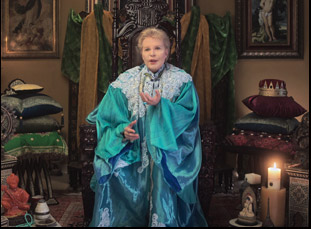There was always magic in how Walter Mercado could bring people together, so when Alex Fumero had set up a call with Kareem Tabsch to talk about a potential film about the larger-than-life astrologer, whose daily forecasts were appointment viewing in his native Puerto Rico and beyond, and got a random call from Cristina Costantini just before, it certainly seemed like a sign, at least in retrospect.
“[Cristina] and I had worked together at Fusion for a few years and she said, ‘I heard you’re obsessed with Walter Mercado. I want to make a movie about him,’” Fumero recalled with a laugh. “And I was like, ‘She can’t know Kareem. This is very strange.’ [And I told her] I have another call in 30 minutes with another director, but maybe you guys can make it together’ — they had different, complementary styles and they were both nice people, so I figured maybe it would work —so I asked Kareem if Cristina could join [the call], I asked Cristina if she would join – they both said yes, to their credit and an hour later, they got on the phone and decided they’d co-direct and I would produce.”
It shouldn’t have been that easy to arrange a partnership with the co-directors of two of 2018’s most heartwarming docs — Costantini followed teenagers with Darren Foster for the charming competition doc “Science Fair” and Tabsch worked with Dennis Scholl to revisit Miami Beach during the 1970s through the lens of Andy Sweet and Gary Monroe’s portraits of the Jewish retirement community in “The Last Resort.” However, with their skills in demand, they give their all to “Mucho Mucho Amor, a beautiful portrait of Mercado, a showman of the highest order who worked as an actor in telenovelas until his exuberant astrological predictions off-camera caught the attention of a general manager at Telemundo who quickly gave him a nightly spot at the network, and by extension, a place in the homes of countless families.
Sadly passing away just after cameras stopped rolling in the fall of 2019, Mercado only reveals his age to others in “Mucho Mucho Amor” as being somewhere “between 50 and death,” an acceptable claim when he has lost none of his youthful spirit and keeps a collection of ornate capes around the house that maintain his regal appearance. But even his most ardent of fans — a group that includes Lin-Manuel Miranda — may not know what happened to him in recent years after he mysteriously disappeared from the airwaves in 2010 and Costantini and Tabsch get to the bottom of a sordid legal drama and bring out the brilliance in their vivacious subject’s open heart and mind, from his longtime relationship with his assistant Willie Acosta to his wonderfully indiscriminate attitude towards religion and culture, infusing his astrological readings with what he found valuable in everything from Buddhism to Christianity.
A celebration of Mercado’s career at the HistoryMiami Museum gives “Mucho Mucho Amor” a rousing finale, but Costantini and Tabsch make every scene feel like a party when Walter’s world is so filled with color, whether in his quick wit or his taste in interior decor, and as the film arrives on Netflix following a premiere earlier this year at the Sundance Film Festival, the two were joined by Fumero to talk about extending Mercado’s already towering legacy by giving him the opportunity to continue bringing joy into the world with his story, realizing they had the responsibility of capturing his final years on camera and getting beyond the image he carefully cultivated over the years to find a man of real beauty behind it.

Cristina Costantini: Kareem found Walter’s nieces at this estate sale and set up a call with [the family]. And we planned for a long time with this call. We wrote a treatment that we were going to pitch. We practiced how we would answer questions, like if [Walter] asked this question, who would answer it, and I remember we had like a very good attack plan going in, but the very first question that [Walter] asked us were what our astrological signs were. That was a total surprise for all of us for some reason. [laughs]
But it was a process of talking and talking the idea through and he hadn’t been in front of a camera on a daily basis for many years at that point, but I think he was eager to be back in the limelight. We realized they had a much different idea of what a documentary is than we did, so it was a learning process on both ends. [Walter] wanted to call “Action” whenever we were shooting and of course, a documentary is [where] we just show up with cameras and you do what you were going to be doing anyway, but for somebody that was media trained, that was a very big leap to get over. The longer we were there, the more trust we got to we got to shoot the kind of documentary we were hoping to make, but it was so fun to be around Walter and for all of us, an immense privilege to be able to capture the last years of this huge icon’s life.
This may be hard to pinpoint, but when Walter’s so image-conscious, did you feel there was a breakthrough moment for you?
Kareem Tabsch: We like to say that we spent the time building the trust, but we also spent the time wearing him down. [laughs] He’s been on television for over 50 years, so he knew exactly what he wanted to look like and he had a lot of rehearsed answers to all the questions that you would think to ask, so getting past that glossy veneer was difficult. But at the same time, that was Walter. When he was just hanging out at home, he might not have been in the capes and the jewelry, but he looked more fabulous than anyone else you could expect. He never left his bedroom without his base face on, so in a sense, it really was who he was all the time.
But in the film, you see him at some very vulnerable moments and discussing things that he normally would discuss and I think that was a combination of building the trust over the two-plus years we worked with him and then just tiring him out because we’re kind of a relentless pair – Cristina’s a brilliant investigative journalist, Alex is a Cuban-American, which means he’s a noodge like me [laughs], and I speak fluent old lady, so the three of us came together and used all of our strengths to just get at him at every angle, and I think it mostly endeared him — sometimes it annoyed him — but the end result was we ended up getting an accurate portrayal of who Walter really was.

Kareem Tabsch: Yeah, when we started making the film, he was dressed all in white and these gold glasses in our very first meeting with him and he looked so old school glamorous. He was on the floor with his dog and so active and just a year later, his health started to decline. I don’t think we expected to really follow the last year in his life — it never seemed like Walter was someone who was not going to be there, but the aging and the deterioration of his health became such a running part of our experience in filming with him. We thought we were going to be tracing this one return-to-glory moment and in reality, it turned out to be a swan song. That wasn’t something we thought was going to happen when it started.
Cristina Costantini: There were also a lot of production challenges that we had to work around because of his health and moments we hadn’t planned for. I always feel like sometimes the things you feel like are mistakes while in production end up being some of your favorite moments, like the house is really a character in the film, and we couldn’t shoot with Walter for a few days because he was in such poor health, so we rented a mannequin at the one mannequin rental store on the island, and some beautiful lights and sliders and started doing the capes and house shoot. It ended up being some of our favorite B-roll and that shoot which we thought was a lost day ended up being incredibly important just in the world building for the film.
Given his limited mobility, what was the Teatro La Perla shoot like? That seems like it must’ve been really special when it’s one of the few places he could go.
Alex Fumero: It was challenging because at that point, he was in a lot of pain and what was interesting for us as filmmakers was it wasn’t until later that we were let in on the severity of some of the stuff that was going on in his hip and his back, so we were insistent in that naive way of [encouraging Walter] like, “When are you ever going to experience this again?” To his credit, he was a real trooper about it and it was amazing to just witness him. You could see him transported in time when he’s on that stage again. One of the most amazing things about Walter is how he’ll just remember lines from a play or an opera that he did 50 or 60 years prior, and to watch him be in both time periods at once as an outside observer, was such an intimate experience you rarely get to see in life.
Kareem Tabsch: And that was his hometown. We took him back to in Ponce, which he had not been to in a few years — since he had his heart attack is what we had heard, so we shot some other stuff that [isn’t in the film], including him walking through the town square and visiting his old high school. Because he was so image-conscious, they didn’t want us to capture him walking too much and were really honest about things, but he was such a professional that he forged ahead, and it was interesting [when he was] in so much pain, but also being in this nostalgia and memories that this visit brought to him.

Cristina Costantini: We showed him about 20 minutes of the film. We submitted the final cut to Sundance on November 1st and he passed away on November 2nd, so that month and the three months that followed were really a whole rollercoaster of emotions for the whole team. He was an icon from our childhood when we started making the film, and by the end we really felt very close to him and his family during the making of the film — we flew back for the funeral, and Alex and Kareem were pallbearers. So it was difficult, but it was also a really exciting time. We made this film in large part to memorialize his contribution to our culture and being able to share it at Sundance in such an incredible forum, surrounded by a lot of Latino people and also people who had never heard of him before was amazing. We feel incredibly blessed that we got to grow up with him, so we wanted to share the brilliance that is Walter Mercado with a wider market as well, and [now] Netflix is an amazing platform for that. It’s going to be 190 countries and 130 languages, so we’re psyched. But everything about that time was bittersweet. It was huge for us to get into Sundance, but also sad that he couldn’t have been there because Sundance would’ve never been done so well as Walter doing Sundance.
“Mucho Mucho Amor: The Legend of Walter Mercado” is now available to stream on Netflix.




